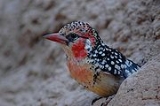
Trachyphonus
Encyclopedia
The African terrestrial barbets are the bird
genus
Trachyphonus in the African barbet family
(Lybiidae
) which was formerly included in the Capitonidae and sometimes in the Ramphastidae. These birds are more terrestrial than the other African barbets and differ in some other respects too; they are thus separated in a monotypic
subfamily Trachyphoninae.
The Early to Middle Miocene
genus Capitonides
from Europe
as well as "CMC 152", a distal carpometacarpus
from the Middle Miocene locality of Grive-Saint-Alban (France
) have been placed into this genus, but this move is not widely accepted. In the case of "CMC 152", this may be more warranted as this fragment differs from Capitonides and is more similar to extant (presumably Old World) barbets.
Bird
Birds are feathered, winged, bipedal, endothermic , egg-laying, vertebrate animals. Around 10,000 living species and 188 families makes them the most speciose class of tetrapod vertebrates. They inhabit ecosystems across the globe, from the Arctic to the Antarctic. Extant birds range in size from...
genus
Genus
In biology, a genus is a low-level taxonomic rank used in the biological classification of living and fossil organisms, which is an example of definition by genus and differentia...
Trachyphonus in the African barbet family
Family (biology)
In biological classification, family is* a taxonomic rank. Other well-known ranks are life, domain, kingdom, phylum, class, order, genus, and species, with family fitting between order and genus. As for the other well-known ranks, there is the option of an immediately lower rank, indicated by the...
(Lybiidae
Lybiidae
The Lybiidae is a bird family containing the African barbets. They were usually united with their American and Asian relatives in the Capitonidae for quite some time, but this has been confirmed to be limited to the main American lineage. There are 42 species ranging from the type genus Lybius of...
) which was formerly included in the Capitonidae and sometimes in the Ramphastidae. These birds are more terrestrial than the other African barbets and differ in some other respects too; they are thus separated in a monotypic
Monotypic
In biology, a monotypic taxon is a taxonomic group with only one biological type. The term's usage differs slightly between botany and zoology. The term monotypic has a separate use in conservation biology, monotypic habitat, regarding species habitat conversion eliminating biodiversity and...
subfamily Trachyphoninae.
Species in taxonomic sequence
- Yellow-billed BarbetYellow-billed BarbetThe Yellow-billed Barbet is a species of bird in the Lybiidae family.It is found in Angola, Benin, Burundi, Cameroon, Central African Republic, Republic of the Congo, Democratic Republic of the Congo, Ivory Coast, Equatorial Guinea, Gabon, Ghana, Guinea, Kenya, Liberia, Nigeria, Rwanda, Sierra...
, Trachyphonus purpuratus - Crested BarbetCrested BarbetThe Crested Barbet is a species of bird in the Lybiidae family.-Appearance:With its thick bill and very colourful plumage the Crested Barbet is unmistakable. This small bird has a speckled yellow and red face with a small black crest. The belly is yellow with red speckles, wings are black with...
, Trachyphonus vaillantii - Yellow-breasted BarbetYellow-breasted BarbetThe Yellow-breasted Barbet is a species of bird in the Lybiidae family.It is found in Burkina Faso, Chad, Djibouti, Eritrea, Ethiopia, Mali, Mauritania, Niger, Nigeria, Somalia, and Sudan.-References:...
, Trachyphonus margaritatus - Red-and-yellow BarbetRed-and-yellow BarbetThe Red-and-yellow Barbet is a species of African barbet found in eastern Africa. The males of the species have distinctive black , red and yellow plumage, while youngsters and females are similar, but a little more dull. The species lives in broken terrain and both nests and roosts in burrows...
, Trachyphonus erythrocephalus - D'Arnaud's BarbetD'Arnaud's BarbetD'Arnaud's Barbet is an African barbet. Barbets and toucans are a group of near passerine birds with a worldwide tropical distribution. The barbets get their name from the bristles which fringe their heavy bills...
, Trachyphonus darnaudii- Usambiro BarbetUsambiro BarbetThe Usambiro Barbet is a subspecies of bird in the Lybiidae family. Most taxonomists consider it to be a subspecies of D'Arnaud's Barbet.It is found in Kenya and Tanzania.-References:...
, Trachyphonus (darnaudii) usambiro
- Usambiro Barbet
The Early to Middle Miocene
Miocene
The Miocene is a geological epoch of the Neogene Period and extends from about . The Miocene was named by Sir Charles Lyell. Its name comes from the Greek words and and means "less recent" because it has 18% fewer modern sea invertebrates than the Pliocene. The Miocene follows the Oligocene...
genus Capitonides
Capitonides
Capitonides is an extinct genus of piciform from the Middle Miocene of southern Germany. Only one species are recorded for genus, Capitonites europaeus.. Carroll assigned the genus to family Capitonidae....
from Europe
Europe
Europe is, by convention, one of the world's seven continents. Comprising the westernmost peninsula of Eurasia, Europe is generally 'divided' from Asia to its east by the watershed divides of the Ural and Caucasus Mountains, the Ural River, the Caspian and Black Seas, and the waterways connecting...
as well as "CMC 152", a distal carpometacarpus
Carpometacarpus
The carpometacarpus is the fusion of the carpal and metacarpal bone, essentially a single fused bone between the wrist and the knuckles. It is a smallish bone in most birds, generally flattened and with a large hole in the middle. In flightless birds, however, its shape may be slightly different,...
from the Middle Miocene locality of Grive-Saint-Alban (France
France
The French Republic , The French Republic , The French Republic , (commonly known as France , is a unitary semi-presidential republic in Western Europe with several overseas territories and islands located on other continents and in the Indian, Pacific, and Atlantic oceans. Metropolitan France...
) have been placed into this genus, but this move is not widely accepted. In the case of "CMC 152", this may be more warranted as this fragment differs from Capitonides and is more similar to extant (presumably Old World) barbets.

